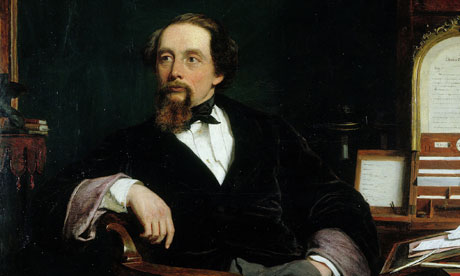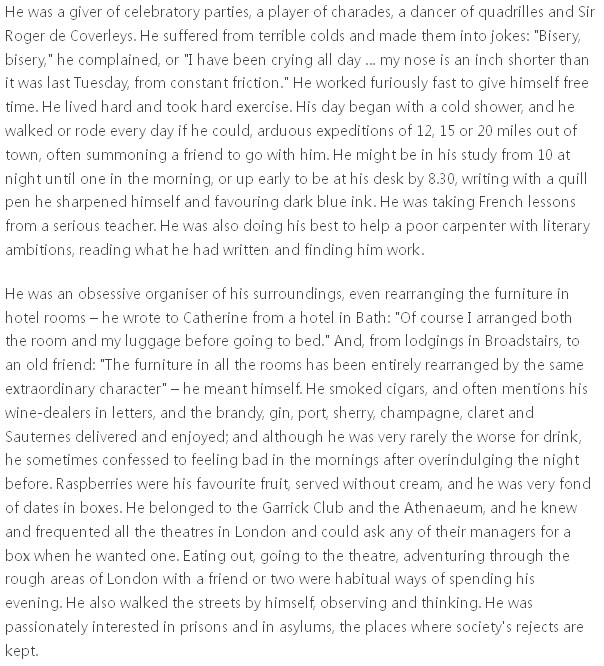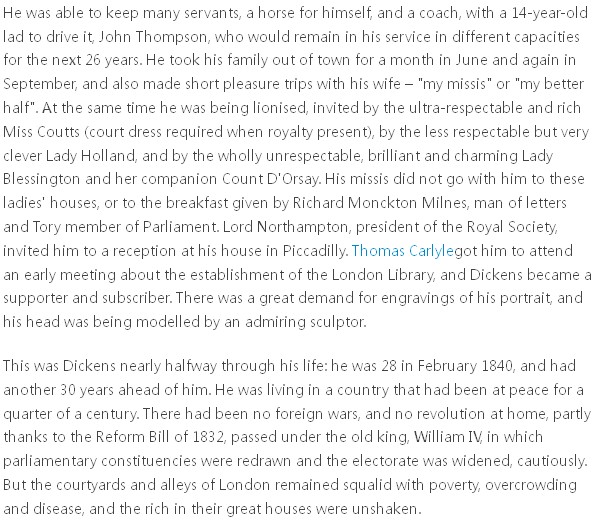The life and times of Charles Dickens

Energy and ambition … detail of a portrait of Charles Dickens by William Powell Frith. Photograph: V&A Images
14 January 1840, London. An inquest is being held at Marylebone Workhouse, a muddled complex of buildings spread over a large area between the Marylebone Road and Paddington Street. The beadle, a parish officer responsible for persuading householders to do their duty as jurors at such inquests, has assembled 12 men. Most of them are middle-aged local tradesmen, but one stands out among them as different. He is young and slight, smartly dressed and good-looking, neither tall nor short at five foot nine inches, with dark hair falling in curls over his forehead and collar. He is a new resident who has just moved into a fine airy house with a large garden, close to Regent's Park at York Gate – No 1 Devonshire Terrace.
it is a different world he has entered through its gates. He is directed to a room in which the other jurors are talking among themselves as they wait for the inquest to begin. They have come to pronounce on a case of suspected infanticide, a servant girl accused of killing her newborn baby in the kitchen of her employers' house. One of the jurors immediately declares himself in favour of the utmost rigour of the law being applied to the young woman. The new young juror recognises him as a furniture-dealer he suspects of cheating him over the recent purchase of a pair of card tables. Another solid parishioner presses his card into his hand, murmuring that he hopes to be of service to him in the future: he is an undertaker.
Before they can settle down for the inquest the jurors must be taken downstairs to the workhouse mortuary in the basement to be shown the body of the baby. It is lying on a box set upon a clean white cloth, with a surgical instrument beside it that has been used to open it up for examination. The baby has been sewn up again. The new juror, who has a two-month-old baby daughter of his own at home – Katey – reflects that it looks as though the cloth were laid and the Giant coming to dinner, but he does not share this thought with his fellow jurors. They agree among themselves that the mortuary is clean and well whitewashed, the foreman says: "All right, gentlemen? Back again, Mr Beadle," and they troop upstairs. The coroner is Thomas Wakley, a surgeon and until recently a member of Parliament. The new juror is Charles Dickens.Now the young woman accused of murder is brought in by one of the workhouse nurses. She looks weak, ill and frightened. She is allowed to sit in one of the horsehair chairs and tries to hide her face on the shoulder of the unsympathetic nurse. Eliza Burgess is 24 or 25 years old, a maid of all work and an orphan, which may be why there is uncertainty about her age. It is likely that she grew up in a workhouse, quite possibly this one. Her story is that on Sunday 5 January, she went into labour in the kitchen of her employers' house, No 65 Edgware Road, where she was the only servant. When the front doorbell rang, she hurried upstairs to let in two lady visitors, and by the time she got back to the kitchen the baby – a boy – had been born under her skirts and appeared to be dead. It is not clear whether the birth took place on the stairs, but she delivered him herself, and must have cut the umbilical cord and cleaned up as best she could. Then she found a box, or a pot, in which she placed the dead newborn child and hid him under the dresser. Her mistress, Mrs Mary Symmons, sent her up to scrub the front-door steps in the cold after her guests left, and then, seeing how ill and thin she looked, taxed her with having given birth. At first she denied it, but then, being threatened with a medical examination, confessed and showed Mrs Symmons where she had put the baby. Mrs Symmons sent for a hackney coach to remove Eliza and her dead child from her house to the Marylebone Workhouse infirmary.
Mrs Symmons appears as an unsympathetic witness and resists questions from Dickens, who hopes to give a favourable turn to the case. The coroner gives a look of encouragement to the juror and the accused girl wails. The next witness is the house surgeon, Mr Boyd, who reports that the accused told him she was seized with labour in the kitchen when the bell was rung by two ladies. She hurried to let them in, and "in the act of doing so the child was born, and on her return it was dead". He is not able to say positively whether it was born alive or dead. Afterwards, in private conversation, Mr Wakley tells Dickens that it is very unlikely that the child could have drawn more than a few breaths, if indeed any, since there was foreign matter in his windpipe.
Miss Burgess is led away while the jurors discuss the case. Dickens resolves to take on those who are ready to find her guilty of killing her child, and, with some encouragement from Mr Wakley, he argues against them, so firmly and forcefully that he wins the argument. When Miss Burgess is brought back the verdict is given: "Found Dead". She falls on her knees to thank the jurors, "with protestations that we were right – protestations among the most affecting that I have ever heard in my life". Then she faints, and is carried away. She will still have to be held in prison and appear at the Old Bailey in due course, but the threat of the death penalty has now been taken from her. Dickens, who is without doubt the busiest man of the 12, goes home and makes arrangements for her to be sent food and other comforts in prison. He also finds an excellent barrister – Richard Doane of the Inner Temple, a friend and amanuensis of the late Jeremy Bentham– to defend her at the Old Bailey trial.That night he cannot sleep. He is overcome with sickness and indigestion, does not want to be alone and asks his wife, Catherine, to sit up with him. The dead baby in the workhouse, the thought of prison and the terrified, ignorant, unhappy young woman prisoner have upset him. In the morning he writes to his closest friend, John Forster, "Whether it was the poor baby, or its poor mother, or the coffin, or my fellow-jurymen, or what not, I can't say …" He already knows a good deal about prisons, since he has seen his father held in one for debt. Also about babies dying, since two of his younger siblings perished early – happily his own three little ones are stout and healthy. And he knows about maids of all work, or "slaveys", well remembering the one who served his family when he was a boy, straight out of the workhouse where she grew up. He recovers from his sickness, and in the evening he and Forster meet at the Adelphi Theatre to see Jack Sheppard – the highwayman – played en travestiby Mary Anne Keeley, an actress well known to Dickens, since he had taken lessons in acting from her husband eight years earlier.Charles Dickenshad been reporting on the world about him for the past six years, as a journalist and then as a novelist. Much of it amused him, but more of it upset him: the poverty, the hunger, the ignorance and squalor he saw in London, and the indifference of the rich and powerful to the condition of the poor and ignorant. Through his own energy and exceptional gifts he had raised himself out of poverty. But he neither forgot it, nor turned aside from the poverty about him. He drew attention to it in his books, and he was personally generous with his time and his money, not only in the case of Eliza Burgess.
Her case came up at the Old Bailey on 9 March and was reported in the Times the next day. She was indicted for unlawfully concealing the birth of a male child delivered on 5 January. Her barrister, Mr Doane, pleaded that she was of weak intellect. He was also able to produce a crucial witness to her character, Mr Clarkson, a tradesman in Great Russell Street; she had previously worked for his family, and he was willing to do his best for her. Mr Clarkson said his wife was greatly interested in Eliza and had got her a promise of a place in the Magdalen Asylum, an institution that looked after young women who strayed from the path of virtue, and did its best to restore them to it. The Clarksons were willing to take her back into their service until she could be admitted there. The willingness of these respectable people to help Eliza was good for her case. The jury found her guilty of concealment but strongly recommended mercy. The judge, Mr Serjeant Arabin, said that under the circumstances he would respite judgment till next session, and that meanwhile she was free. Nothing more is heard of her except a brief word by Dickens that her sentence had been lenient, and that "her history and conduct proved it right". This was written 23 years later, in 1863: Dickens had stored up the memory of the sad young woman.
This is a very small episode in the life of Dickens, but it allows us to see him in action, going to the workhouse just along the road from his own home, and deciding to help a young woman whose character and history are quite without interest or colour, and who comes from the very bottom of the social heap, a workhouse child, a servant and a victim – a victim of ignorance, of gullibility, of an unknown seducer and a harsh employer, and of the assumptions made by respectable jurors. He is at his best as a man, determined in argument, generous in giving help, following through the case, motivated purely by his profound sense that it was wrong that she should be victimised further.
(接下)












 京公网安备 11010802032529号
京公网安备 11010802032529号